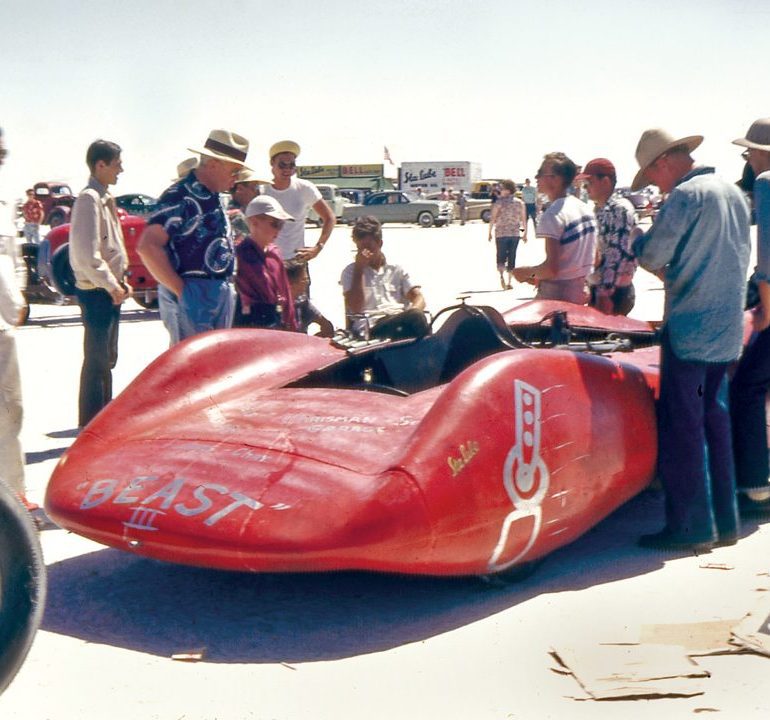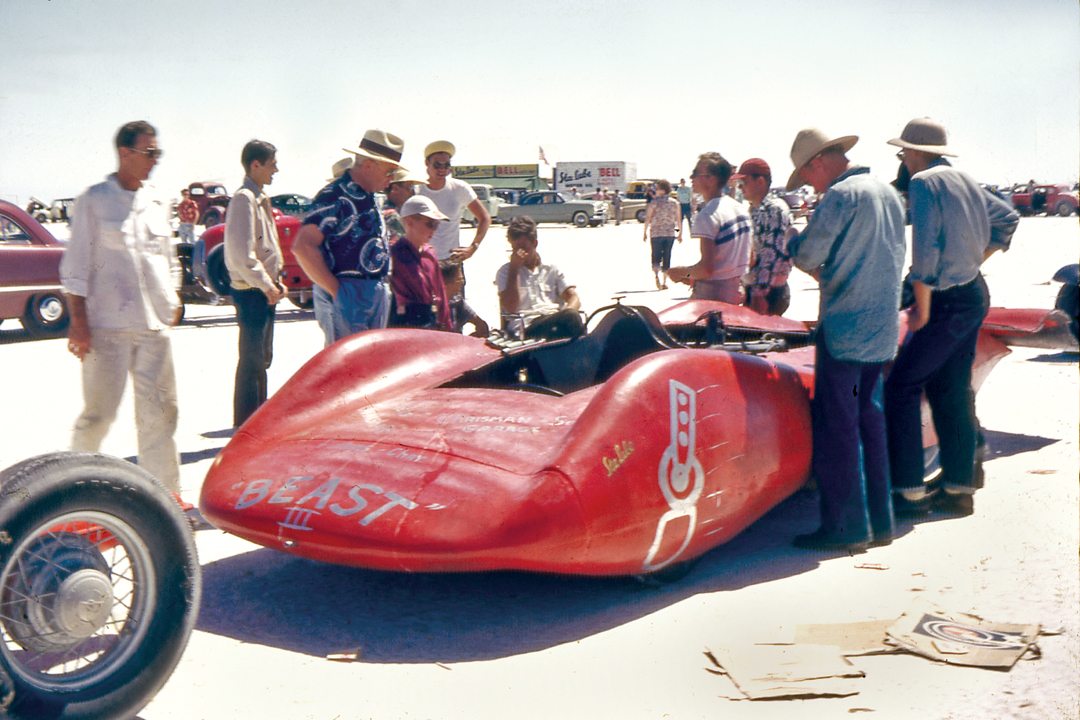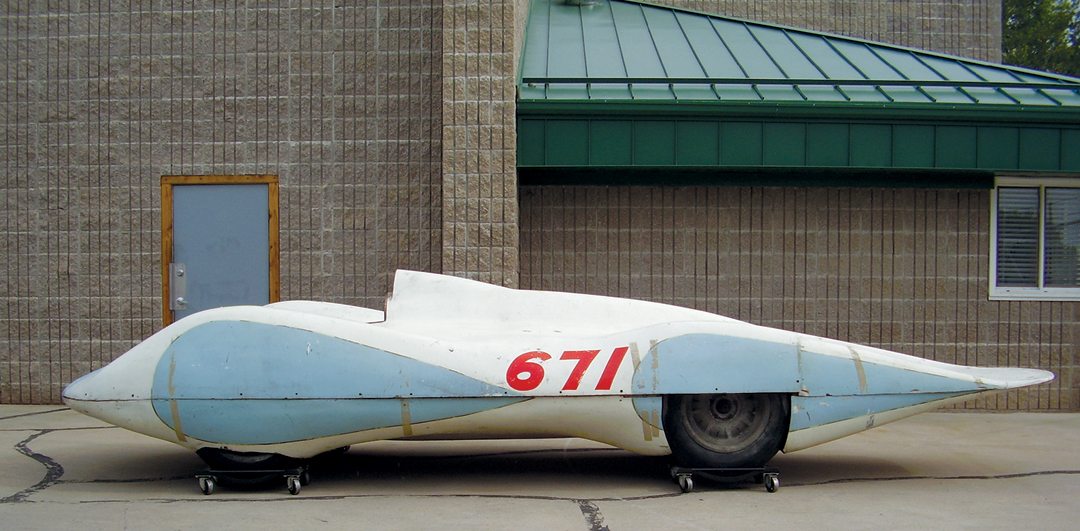The story of Chet Herbert is pure inspiration. Afflicted with polio at age 20, Herbert spent his life building a string of record-smashers from his wheelchair…and apparently he thought nothing special of it.
Following WWII, Herbert opened the doors to his speed shop, grinding some of the finest camshafts that could be had. In 1950, he built Beast I, a modified “Knucklehead” that he tuned to a speed of 128 mph at the dry lakes. This bike was heavily campaigned and was also a record-breaker at the drag strips. Beast II was the next Herbert creation, a drag racecar that was also a strong competitor.
Encouraged by these two “Beastly” endeavors, Herbert began to plan his most serious racing effort in early ’52. Beast III was to be Herbert’s ultimate machine, a Bonneville Streamliner conceived to race to unthinkable speeds.
It started with a 1/10th scale model Streamliner formed from aluminum over clay and wood patterns. Herbert used it for a series of wind-tunnel tests and refined the shape based on data recorded. Such testing was extremely forward-thinking in 1952 and, according to a December ’52 article in Hot Rod magazine, these were “the first such extensive tests conducted in the U.S. on a land borne vehicle.”
Once the most slippery and stable shape was determined, the model’s form was finalized and the job of building the full-size body was turned over to the Shapel Engineering Company of Los Angeles. Here again Herbert was intent on pioneering new frontiers and chose what was then the space-age material of fiberglass. The shape was not only purposeful and aggressive but was an absolute visual stunner. At 20 feet long, Beast III was fully enclosed with a tail that seemed to go on forever. According to the president of the Society of Land Speed Racing Historians, Jim Miller, “Beast III in my mind was the greatest of the early Streamliners that ran on the salt. Chet and Rod Shapel really got the shape right on that one, and it influenced many of the liners that followed. To me, this is the all-time quintessential Streamliner.”
Herbert initially experimented with the idea of running the car with a modified aluminum 330-cubic-inch, 6-cylinder, Franklin aircraft engine. When the motor exploded during dyno testing at Tony Capanna’s shop, he quickly discarded that notion. He briefly contemplated using a supercharged Miller engine, but ultimately decided to go with the most potent V-8 available…the Chrysler Hemi. Truck fleet-owner Dana Fuller of San Mateo, California, a friend of Herbert’s, agreed to provide the engine. Herbert heavily modified the ’51 Hemi monster and equipped it with his perfect roller cams, Hilborn-Travers fuel injection, and a Vertex magneto. Four individual exhaust stacks were fabricated to extend through each side of the body.
The chassis was a partially completed unit with two 3-inch tubular sections that Herbert sourced from Paul Sylva of Inglewood, California. Front suspension was by torsion bar and the rear suspension was torsilastic. He substantially reconstructed the chassis in order to move the pilot forward to accommodate the rear-mounted engine. The cover of the December 1952 issue of Hot Rod shows Herbert busy at work on the chassis from his wheelchair.
This was an all-out assault on speed, and Herbert was uncompromising in his choice of components. Beast III’s equipment included a Halibrand quick-change tube axle unit with an aircraft-type spot brake, 18-inch Halibrand “no window” cast magnesium wheels riding on Firestone Indianapolis racing tires, hand-operated brake and shift levers, and foot-operated clutch and accelerator. Gear shifts were by a Ford V-8 side-shift unit with a Cook adapter.
One of the truest truisms about Salt Flats racing is “no matter how early in the year you get started, you’re always rushing to get the car ready as Speed Week approaches.” This was never truer than with the Beast III project. As time flew by, Herbert realized he needed additional manpower to finish the car in time for the meet, and he called on his friends at Chrisman & Sons Garage of Compton, California.
The Chrismans turned their entire facility over to Herbert and Chrisman Sr., sons Art and Floyd, and a host of others, got down to work on the Beast. From all accounts it was a marathon effort and at several points it seemed as if the car would never be ready in time. In fact, the feature article in Hot Rod was aptly titled “The Impossible Car That Came True.”
According to Herbert, “The building of that car was a real accomplishment. At the end, we did it with volunteer labor. Some of the guys were working jobs during the day so they could only come at night. We were working around the clock, 24 hours a day. I couldn’t count on who was coming, so I stayed there all that time for three or four days, awake the whole time working. I got so tired that they tied me in my wheelchair with a belt to keep me from falling out.”
Miraculously, the car was completed a few days after Speed Week began and Herbert and his crew hopped in the truck and drove all night. The liner arrived on the salt on August 27, which was the fifth day of the meet. Officially entered as the “Herbert Cams Special,” the car ran as a D-Streamliner appropriately adorned with the beastly number 666.
Herbert and driver George Bentley quickly got down to business. Beast III went 182 mph, 197 mph, and 211 mph in its first three attempts. The next day Art Chrisman took over the driving duties, clocking 219, 224, 230, and finally an amazing 235.991 with a one-way best mark of 238.095.
This herculean effort with Beast III put Chrisman in the 200 mph Club as its 10th inductee. It also made this Streamliner the fastest single-engine car in America.
For Bonneville ’53, Herbert partnered with Dana Fuller, who ran the Streamliner with a 425 cubic-inch, 6-71 GMC diesel engine equipped with an experimental cylinder head and two superchargers. Fuller drove it (# 671) to two diesel world records.
Fuller retired the car sometime in the mid-’50s, and it sat idle for nearly fifty years. Land speed racer Ed Hegarty ultimately bought it from Fuller’s family in 2002 with the plan of getting it running, but that didn’t happen. In early 2009, the car quietly came to the attention of hot rod expert Dave Crouse of Custom Auto in Loveland, Colorado. According to Crouse, “This car is incredibly well preserved which is extremely unusual for an early ’50s Streamliner. This car was written up in all the magazines and, in my mind, is one of the most important land speed cars of all time.”
Crouse offered the car to David Duthu who owns Beast IV, which is currently under restoration in Crouse’s shop. Duthu passed, but told Crouse of a fellow Houston-based maniac who might go for it. After some phone calls to Duthu’s friend and an exchange of money, Crouse transported the car back to his shop and is now staring at both Beast III and IV under one roof.
Oh, yeah. The maniac in Houston is me.






